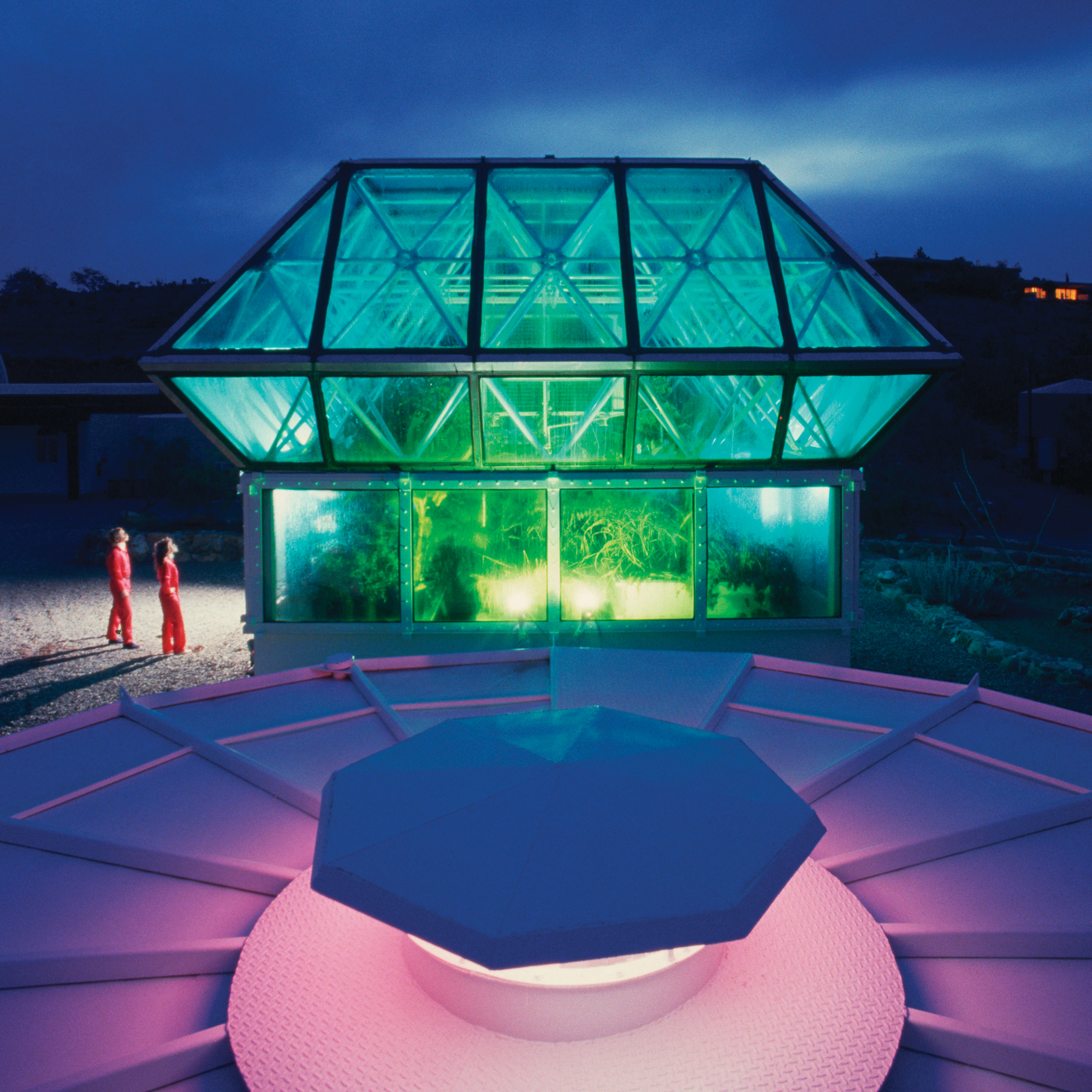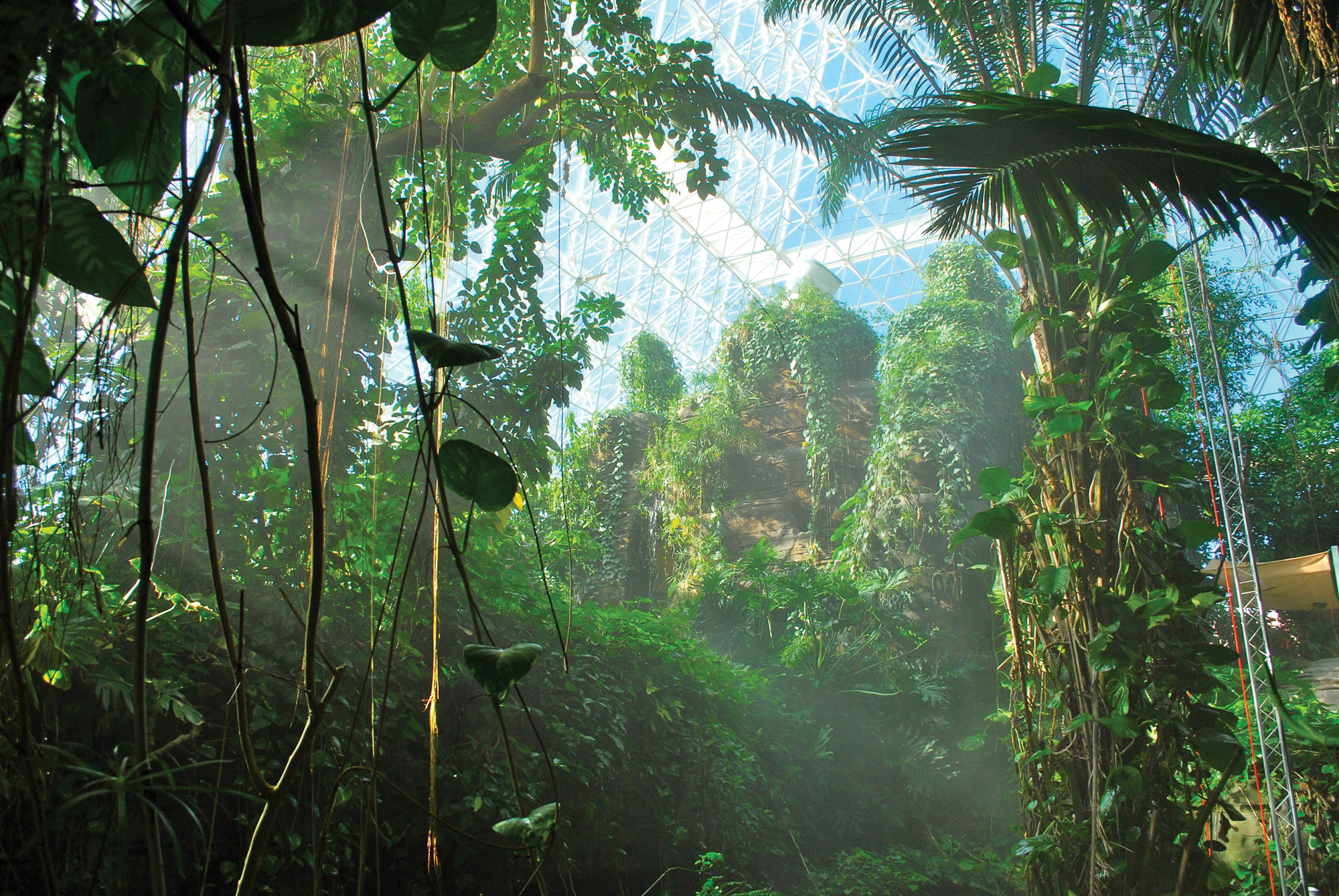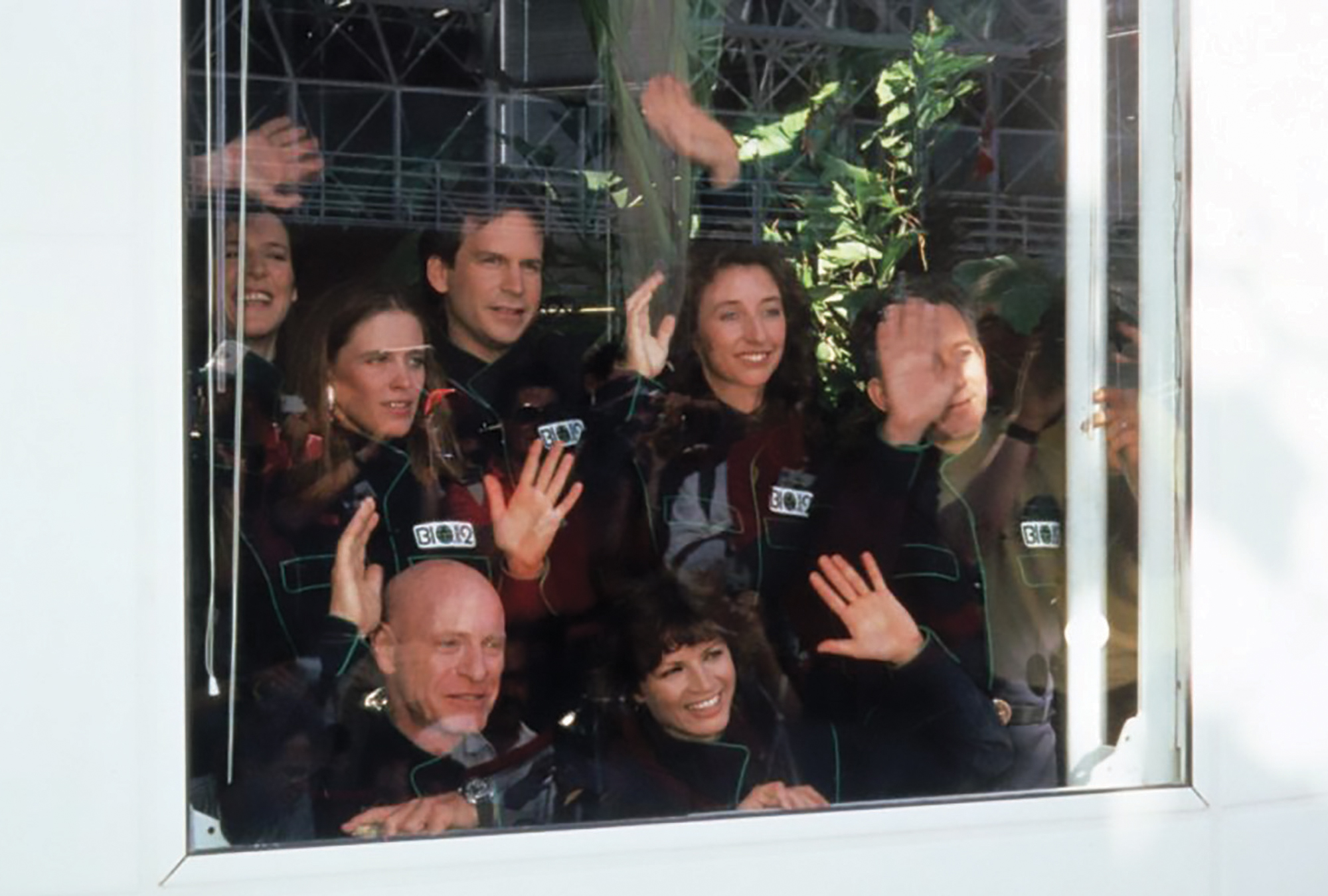In the fall of 1991, I was sealed into an airtight, three-acre mini-world called Biosphere 2, a $150-million futuristic facility near the aptly named town of Oracle, Arizona. I joined seven other explorers in a daring, high-profile study of sustainability and the new science of biospherics—the study of closed systems that mimic Earth’s environment.
It was right out of a science fiction movie, and unlike anything previously attempted on such a scale. Our goal was to spend those two years studying how a mini-biosphere—complete with wilderness areas, a farm and a group of humans—would work with as few outside inputs as possible. A privately funded venture, Biosphere 2 had three main goals—education, eco-technology development and learning how well our eco-laboratory worked. We also hoped to help NASA and other space agencies learn more about life-support systems for long-term space missions.
In case you’re wondering what Biosphere 1 is, you’re living on it—planet Earth. That’s the best way to understand my trip to the ecological frontier. I lived in a miniature Earth to better understand fundamental processes of biospheres to improve how humans relate to our world.

Our crew—the biospherians—consisted of a multinational tribe: five Americans, two Brits and one Belgian; we were four men and four women. We included a botanist, a marine biologist and a physician. (I managed the wastewater recycling system and assisted in ecological and agricultural research.) Together we became the first natives of a new techno-living synthesis.
We had no operating manual.
The planning and construction of Biosphere 2 took seven years. As one of our many scientist consultants said, “When you build a new world, you have all the problems in the world to solve.” Many experts thought we were 50 years ahead of our time.
We hoped the project would fire the public’s imagination. The architecture blended glass Mayan pyramidal shapes with dazzling white Buckminster Fuller-type geodesic domes and barrel-vaulted chambers straight out of ancient Babylon. Inside we built a bonsai world. Its wilderness biomes included a rainforest with a 25-foot waterfall, a grassy treed savannah, a desert, fresh and saltwater wetlands with mangrove trees and a coral reef in a 25-foot-deep, 150-foot-long ocean (the source of our table salt).
Our engineers faced huge challenges. They had to replicate many of Earth’s free services, such as ocean waves (they used vacuum pumps). They had to ensure each biome had correct temperatures and rainfall amounts, desalinate water, collect and circulate water, treat wastewater, strip our air of trace gases and even create mild breezes.
We hoped Biosphere 2 would fire the public’s imagination.
Biosphere 2 had to support life while not unwittingly polluting it with machines and materials whose presence might have unforeseen side effects. Everything that went inside was screened to avoid synthetic materials that emit trace amounts of noxious gases our life systems couldn’t handle. As a result, wool and wood were used for flooring, wall paneling and furnishings in living areas. Chemical deodorants and cleaning supplies weren’t allowed. Same with fires—even lit birthday candles.
Inside the Bubble
On September 26, 1991, we entered Biosphere 2 to begin our experiment. Like astronauts, we had plenty of tasks to fill our days. Farming took up 25 percent of our waking time, research and maintenance 20 percent, writing reports 19 percent, cooking 12 percent, biome management 11 percent, animal husbandry 9 percent. We spent the rest of our time doing media interviews and handling miscellaneous matters. We built in off days for rest and to observe changes in our growing biosphere.
We grew our food and raised and slaughtered livestock. We worked in labs, maintained equipment, and spent time in our living quarters. Growing good nutritious food was a top priority, requiring everyone to work three to four hours a day for five days a week. None of us had come from a farming background. Hunger became a new experience—and our constant companion. We existed the way humans had for time immemorial. Did our farming improve as we went along? You bet. Hunger is a great motivator. If you don’t grow it, you can’t eat it.
Among our 80 crops were rice, yams, peanuts, sorghum, millet, beets, wheat, carrots, peppers, bananas, figs, tomatoes, kale, eggplant, onions, papayas, beans, sweet and white potatoes, squash and herbs. A total of 3,000 species of plants and animals coexisted in Biosphere 2. Since we couldn’t use chemical pesticides, we used biological controls such as ladybugs to eat pests. We imported four species of beneficial cockroaches to recycle organic matter. Unfortunately, that great evolutionary survivor—the household cockroach—snuck in and exploded in crop-threatening numbers, as did another stowaway species, ants.

We reveled in simple pleasures. One delight was coffee made from beans from our young rainforest’s coffee trees, which we could make only once every two or three weeks. We treasured each cup. For a pizza, we spent four months growing a crop of wheat, which then had to be threshed and ground. Tomatoes, peppers and onions had to ripen. No 30-minute delivery for us.
Though we had a mostly vegetarian diet, we occasionally made special dishes from small amounts of meat (a quarter pound per person per week), eggs and milk. We raised a species of small pigs, pygmy goats and a variety of chickens—a scrappy Mexican breed, elegant Japanese Silkies and bantams with cocky attitudes.
Fish was a rare treat. We raised and harvested tilapia in rice paddies. Dozens of species of tropical fish—and 2-foot-long giant Pacific clams—populated our ocean. We didn’t eat them, but we did enjoy snorkeling in the world’s largest manmade coral reef ocean.
We found satisfaction in caring for our animals and even gave them names. Our milking goats included Milky Way, Stardust and Vision. We dubbed two pigs Zazu and Quincy. One of our daffier chickens was Mrs. Fruitcake.
One delight was coffee made from beans from our young rainforest’s coffee trees, which we could make only once every two or three weeks.
That we biospherians humanely killed and processed our domestic animals caused disbelief and curiosity among visitors. Yet despite not using chemical fertilizers or pesticides, our farm was the most productive half acre in the world. We grew 83 percent of our food. Our doctor, who monitored our caloric intake daily and gave us frequent medical tests, called our high-protein, low-calorie meals a “healthy starvation” diet. I lost 25 pounds, and sometimes I got so hungry I ate peanuts with their shells on.
We became inventive with dishes and flavors. We each ate more than a pound of sweet potatoes a day. Through time, we worried that the beta carotene that gives them and bananas and carrots their distinctive colors would turn us a disconcerting orange hue. We never noticed any change, but eventually outsiders grew alarmed at our new complexions.
Despite our limited food supply, we reserved some goodies for feasts and celebrations. We made cheese, ice cream and fruit smoothies. We even sauced up the occasional party with banana wine, rice beer and beet whiskey, which everyone abhorred, even while drinking it.
Our doctor had pioneered our high-nutrient diet at UCLA’s med school, but no one had studied its effects on humans. His research indicated that our bodies became highly efficient at utilizing nutrients in everything we ate. We gained back some of our weight losses after our bodies adjusted to an initial 1,800-calorie-a-day regimen. As we became better farmers, our intake rose to 2,200 calories a day.
Just as our farm and livestock thrived, so did our biomes. Their total biomass—the weight of all the plants—more than doubled. We had “species-packed” each eco-area. While some plants and trees died, the crew controlled invasive species, and biomes grew rapidly and maintained remarkable diversity despite their small areas. The desert, for example, transformed from an area dominated by cactus to one populated by shrubs and trees. We let this process unfold. In this biome, the biosphere taught us how it wanted to evolve.
For entertainment and companionship, we brought in prosimian galagos, known as “bush babies.”
In other biomes, we had to intervene to ensure their stability. For example, the reef in our ocean thrived in part because we removed sunlight-blocking algae and managed its water quality. In the rainforest, morning glories went on a purple rampage that forced us to spend hours yanking down their choking vines.
The Human Element
We reveled in the day-by-day sensual pleasures of each biome’s distinctive smells, sounds and landscapes. We celebrated our world in poetry, film, writing, art and music in inter-biospheric arts festivals with outside artists. For entertainment and a kind of companionship, we brought in prosimian galagos, known as “bush babies.” These tree-dwelling nocturnal African animals weigh two-and-a-half pounds and live on fruit and insects. Their monkey-like curiosity led them to explore all parts of our little world.
Crew members could meet friends and family at windows or via telephone, but inside it was just the eight of us. We profoundly got to know each other. I could tell by a footstep or breathing who was passing my room.
We contracted a syndrome psychologists call irrational antagonism. That is, we split into two groups of four. A power struggle over the project’s direction made things much worse. One side wanted new management and to reconfigure our mission priorities by deemphasizing closure and spending more time on science. The other side wanted to keep the project’s leadership and our objectives intact. “It was really pretty awful,” one crewmate later recalled. “I could be so cold to the people in the other group, walking by them and not even looking at them.” While there were no fistfights, one crew member complained years later she had been spit at. Twice.

We worked on healing the rifts, reading books on group dynamics and having homegrown group therapy sessions. As much as possible we kept our conflicts in the open. No matter how much we disagreed, we continued to work together. There was never an instance of subconscious sabotage of Biosphere 2 or anyone’s research. It helped immeasurably that everyone was committed to Biosphere 2’s success.
From the outset, we agreed we wouldn’t trivialize our experience by talking about our sex lives. We didn’t speak about sex to the media. When asked, our stock answer was, “People are people. Everything you might expect to happen with people has happened in here.” That said, there were two male-female couples among us, and the rest of us were single. I spent two years as a happy eco-monk.
To Air is Human
Several months in, we realized our oxygen levels were falling. Rather than throwing in the towel by pumping oxygen into Biosphere 2, we decided to study the problem and how it affected us. After 16 months, our oxygen level had dropped from 20.9 percent to 14.2 percent, the equivalent of living at a 15,000-feet elevation. Half of us suffered noticeable symptoms of altitude sickness, including sleep apnea. Fearful that the lack of oxygen might affect our thinking, we told our on-call outside medical team to consider overruling our doctor’s decisions about our well-being. One day he found that he couldn’t add a column of numbers.
At that point, everyone agreed we had reached a dangerous breaking point.
Refrigerated trucks arrived to pump pure oxygen into Biosphere 2. At first it was pumped into only one of the biosphere’s chambers. The effect was jubilation. We began madly laughing and running. “I felt like a born-again breather, praising oxygen,” said one crewmember. It was one of the most dramatic physiological revivals of my life—underlining how we take life-giving oxygen for granted. Prior to that, observers said watching us work was like viewing a slow-motion dance. Take a bow, green plants and ocean algae. Without you, Earth might have an atmosphere like that on Mars.
What caused the crisis? Microbes in our organically enriched soils had produced carbon dioxide at a greater rate than our young plants could produce oxygen via photosynthesis. We discovered that most of the missing oxygen was converted to CO2 and had been absorbed by the unsealed concrete in our habitat.
Reentry
We emerged from Biosphere 2 on September 26, 1993, having completed our mission. All eight of us were profoundly changed.
We were in remarkably good health. We had the body-fat content of pro athletes and lower blood pressure and cholesterol levels than we had going in. Emotionally, stepping outside was like leaving a lover who had taken tender care of me. Biosphere 2 was our baby, and we had grown and been transformed by it. We’d felt a oneness with it, a deep visceral connection. We knew our health depended on our biosphere’s health.
We were happy to be stars of our New-Age zoo.
My first trips to supermarkets were strangely disorienting. I went back to eating meals without knowing where and how each ingredient was grown, harvested and processed. I realized my former world had no trash, packaging or pollution-causing cars and no annoying, absurd things. Everything in Biosphere 2 made sense. It was an incredibly sensitive world. Everything we did had consequences and greatly increased our mindfulness.
Unfortunately, our outward sci-fi appearance may have worked too well. Biosphere 2 made headline news around the world, but we didn’t foresee that being so high-profile would lead to such sensational coverage. Early on, we were hyped as “The Project that Will Save the World.” Then we suffered the inevitable mockery and dismissal. “Pseudo-science stunt” was one insult.
Sadly, much of what we learned went unappreciated. Overwrought media coverage led people to think the experiment failed. But a million visitors came to peer into Biosphere 2, and millions more followed us in news accounts. We were happy to be stars of our new-age zoo, a living exhibit that increased human understanding of our relationship with our global biosphere.
Biosphere 2, the greatest experiment ever conducted in ecological self-organization, revolutionized the field of experimental ecology. We proved that a sealed ecosystem can work for years, a lesson Mars colony planners can build on. We learned lessons to help keep stressed reefs alive and how to protect rainforests. We worked with our green allies to keep CO2 from getting too high. Our farm showed that high productivity and full nutrient recycling could be done without toxic chemicals.
Today I remain optimistic that humans can solve the problems they cause. My optimism, in large degree, comes from my Biosphere 2 experience, which taught us every action, however small, is important. “We may have come in separate ships, but we’re all in the same boat now,” said Martin Luther King Jr. We understood this in Biosphere 2, and I see a growing appreciation around the world that we’re in a shared lifeboat, regardless of our origins and circumstances. We are facing a species IQ test that will determine if humans can show the intelligence, resilience and adaptability to be a cooperative, creative part of our planetary biosphere—or whether we are headed to an evolutionary dead-end.
This is the exhilarating and yes, scary, challenge of our time. But we have allies. As we so unforgettably learned in Biosphere 2, we are all part of the biosphere, body and soul.
The biosphere is on our side.
Mark Nelson is the author of Pushing Our Limits: Insights from Biosphere 2, from which parts of this article are adapted. He is a founding director of the Institute of Ecotechnics in Santa Fe, New Mexico, and London.
This article originally appeared in print with the headline, “Out of This World.”




